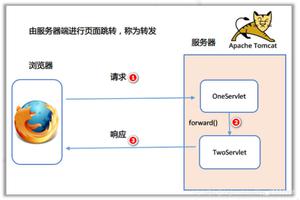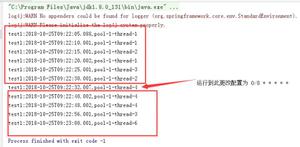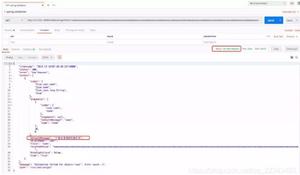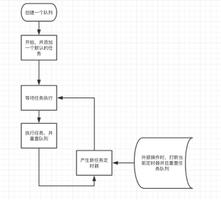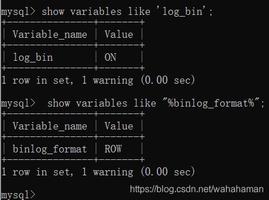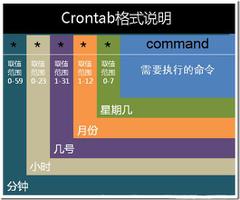SpringTask定时任务的使用
本文内容纲要:
- 1.基于xml配置的简单的使用- 2.基于注解的使用
实现定时任务简单的有四种方式:Timer\ScheduledThreadPool线程池\quartz(常用),还有另一种就是springtask。
都说springtask上手简单,于是简单的研究一下springtask的使用,并且运用到自己的项目中。其也有两种配置方式,第一种是基于xml配置,第二种是基于注解。
SprngTask没有专门的包,其核心类位于spring-context包中。所以引入spring的核心包此功能即可使用。
在实际的项目中,我们经常将job作为action层,在job中注入service去操作底层的dao,或者定时的向其他系统拉取数据,再或者向其他系统推送数据。
1.基于xml配置的简单的使用
测试类:(每五秒钟打印一次日志)
package cn.xm.exam.job;import org.slf4j.Logger;
import org.slf4j.LoggerFactory;
import org.springframework.stereotype.Component;
@Component
public class FirstTestJob {
private static final Logger log = LoggerFactory.getLogger(FirstTestJob.class);
private static int count;
public void cron() {
log.info("spring task execute times {}", count++);
}
}
xml配置:(非常类似于quartz的cron表达式和linux定时的cron表达式)
<?xml version="1.0" encoding="UTF-8"?><beans xmlns:xsi="http://www.w3.org/2001/XMLSchema-instance"
xmlns="http://www.springframework.org/schema/beans" xmlns:context="http://www.springframework.org/schema/context"
xmlns:aop="http://www.springframework.org/schema/aop" xmlns:tx="http://www.springframework.org/schema/tx"
xmlns:task="http://www.springframework.org/schema/task"
xsi:schemaLocation="http://www.springframework.org/schema/beans http://www.springframework.org/schema/beans/spring-beans-3.2.xsd http://www.springframework.org/schema/context http://www.springframework.org/schema/context/spring-context-3.2.xsd http://www.springframework.org/schema/aop http://www.springframework.org/schema/aop/spring-aop-3.2.xsd http://www.springframework.org/schema/tx http://www.springframework.org/schema/tx/spring-tx-3.2.xsd http://www.springframework.org/schema/task http://www.springframework.org/schema/task/spring-task-3.2.xsd">
<context:component-scan base-package="cn.xm.exam.job"></context:component-scan>
<task:scheduled-tasks>
<task:scheduled ref="firstTestJob" method="cron"
cron="0/5 * * * * ?" />
</task:scheduled-tasks>
</beans>
重点是引入task的schema:
xmlns:task="http://www.springframework.org/schema/task"http://www.springframework.org/schema/task http://www.springframework.org/schema/task/spring-task-3.2.xsd
结果:
...2018-11-14 22:35:00 [cn.xm.exam.job.FirstTestJob]-[INFO] spring task execute times 59
2018-11-14 22:35:05 [cn.xm.exam.job.FirstTestJob]-[INFO] spring task execute times 60
2018-11-14 22:35:10 [cn.xm.exam.job.FirstTestJob]-[INFO] spring task execute times 61
2018-11-14 22:35:15 [cn.xm.exam.job.FirstTestJob]-[INFO] spring task execute times 62
2018-11-14 22:35:20 [cn.xm.exam.job.FirstTestJob]-[INFO] spring task execute times 63
2018-11-14 22:35:25 [cn.xm.exam.job.FirstTestJob]-[INFO] spring task execute times 64
...
2.基于注解的使用
首先查看注解的源码:
注解使用必须在xml中开启注解任务,使注解生效:
<?xml version="1.0" encoding="UTF-8"?><beans xmlns:xsi="http://www.w3.org/2001/XMLSchema-instance"
xmlns="http://www.springframework.org/schema/beans" xmlns:context="http://www.springframework.org/schema/context"
xmlns:aop="http://www.springframework.org/schema/aop" xmlns:tx="http://www.springframework.org/schema/tx"
xmlns:task="http://www.springframework.org/schema/task"
xsi:schemaLocation="http://www.springframework.org/schema/beans http://www.springframework.org/schema/beans/spring-beans-3.2.xsd http://www.springframework.org/schema/context http://www.springframework.org/schema/context/spring-context-3.2.xsd http://www.springframework.org/schema/aop http://www.springframework.org/schema/aop/spring-aop-3.2.xsd http://www.springframework.org/schema/tx http://www.springframework.org/schema/tx/spring-tx-3.2.xsd http://www.springframework.org/schema/task http://www.springframework.org/schema/task/spring-task-3.2.xsd">
<context:component-scan base-package="cn.xm.exam.job"></context:component-scan>
<!-- 开启注解任务 -->
<task:annotation-driven />
</beans>
测试类:(每十秒钟打印一次日志)
package cn.xm.exam.job;import org.slf4j.Logger;
import org.slf4j.LoggerFactory;
import org.springframework.scheduling.annotation.Scheduled;
import org.springframework.stereotype.Component;
@Component
public class FirstAnnotationJob {
private static final Logger log = LoggerFactory.getLogger(FirstAnnotationJob.class);
private static int count;
@Scheduled(cron = "0/10 * * * * ?")
public void cron() {
log.info("spring anno task execute times {}", count++);
}
}
结果:
2018-11-14 22:44:40 [cn.xm.exam.job.FirstAnnotationJob]-[INFO] spring anno task execute times 02018-11-14 22:44:50 [cn.xm.exam.job.FirstAnnotationJob]-[INFO] spring anno task execute times 1
2018-11-14 22:45:00 [cn.xm.exam.job.FirstAnnotationJob]-[INFO] spring anno task execute times 2
2018-11-14 22:45:10 [cn.xm.exam.job.FirstAnnotationJob]-[INFO] spring anno task execute times 3
查看@Scheduled的源码:(位于spring-context包内)
/** <a href="http://www.cpupk.com/decompiler">Eclipse Class Decompiler</a> plugin, Copyright (c) 2017 Chen Chao. */package org.springframework.scheduling.annotation;
import java.lang.annotation.Documented;
import java.lang.annotation.ElementType;
import java.lang.annotation.Retention;
import java.lang.annotation.RetentionPolicy;
import java.lang.annotation.Target;
@Target({ElementType.METHOD, ElementType.ANNOTATION_TYPE})
@Retention(RetentionPolicy.RUNTIME)
@Documented
public @interface Scheduled {
/**
* A cron-like expression, extending the usual UN*X definition to include
* triggers on the second as well as minute, hour, day of month, month
* and day of week. e.g. {@code "0 * * * * MON-FRI"} means once per minute on
* weekdays (at the top of the minute - the 0th second).
* @return an expression that can be parsed to a cron schedule
* @see org.springframework.scheduling.support.CronSequenceGenerator
*/
String cron() default "";
/**
* Execute the annotated method with a fixed period between the end
* of the last invocation and the start of the next.
* @return the delay in milliseconds
*/
long fixedDelay() default -1;
/**
* Execute the annotated method with a fixed period between invocations.
* @return the period in milliseconds
*/
long fixedRate() default -1;
/**
* Number of milliseconds to delay before the first execution of a
* {@link #fixedRate()} or {@link #fixedDelay()} task.
* @return the initial delay in milliseconds
* @since 3.2
*/
long initialDelay() default 0;
}
参数解释:(其实源码的注释也写的非常清楚了)
cron:cron表达式
fixedDelay:表示从上一个任务完成开始到下一个任务开始的间隔,单位是毫秒
fixedRate:从上一个任务开始到下一个任务开始的间隔,单位是毫秒。
initialDelay:任务第一次被调用前的延时,单位毫秒。
需要注意的是上面的前三个属性只能保留一个,不能同时出现,最后一个延时操作可以与上面三个参数搭配。否则会报异常如下:
java.lang.IllegalArgumentException: Exactly one of the 'cron', 'fixedDelay', or 'fixedRate' attributes is required.接下来我们测试上面的参数:
fixedDelay :方法中模拟处理用了2spackage cn.xm.exam.job;
import org.slf4j.Logger;
import org.slf4j.LoggerFactory;
import org.springframework.scheduling.annotation.Scheduled;
import org.springframework.stereotype.Component;
@Component
public class FirstAnnotationJob {
private static final Logger log = LoggerFactory.getLogger(FirstAnnotationJob.class);
private static int count;
@Scheduled(fixedDelay = 10000)
public void cron() {
try {
Thread.sleep(2000);
} catch (InterruptedException e) {
log.error("InterruptedException ", e);
}
log.info("spring anno task execute times {}", count++);
}
}
结果:(实际每两次任务中间相差12s,也就是第一次任务结束10s后开启下次任务)
2018-11-14 23:02:04 [cn.xm.exam.job.FirstAnnotationJob]-[INFO] spring anno task execute times 12018-11-14 23:02:16 [cn.xm.exam.job.FirstAnnotationJob]-[INFO] spring anno task execute times 2
2018-11-14 23:02:28 [cn.xm.exam.job.FirstAnnotationJob]-[INFO] spring anno task execute times 3
2018-11-14 23:02:40 [cn.xm.exam.job.FirstAnnotationJob]-[INFO] spring anno task execute times 4
fixedRate测试:
package cn.xm.exam.job;import org.slf4j.Logger;
import org.slf4j.LoggerFactory;
import org.springframework.scheduling.annotation.Scheduled;
import org.springframework.stereotype.Component;
@Component
public class FirstAnnotationJob {
private static final Logger log = LoggerFactory.getLogger(FirstAnnotationJob.class);
private static int count;
@Scheduled(fixedRate = 10000)
public void cron() {
try {
Thread.sleep(2000);
} catch (InterruptedException e) {
log.error("InterruptedException ", e);
}
log.info("spring anno task execute times {}", count++);
}
}
结果:(每两次任务相差10s,也就是本次任务开始之后10s后就开启下次任务,不管中间处理花费多长时间)
2018-11-14 23:04:47 [cn.xm.exam.job.FirstAnnotationJob]-[INFO] spring anno task execute times 12018-11-14 23:04:57 [cn.xm.exam.job.FirstAnnotationJob]-[INFO] spring anno task execute times 2
2018-11-14 23:05:07 [cn.xm.exam.job.FirstAnnotationJob]-[INFO] spring anno task execute times 3
至此完成了springtask的测试,确实比quartz简便的多,使用也简单。
附一个在线cron表达式生成器:http://cron.qqe2.com/
本文内容总结:1.基于xml配置的简单的使用,2.基于注解的使用,
原文链接:https://www.cnblogs.com/qlqwjy/p/9960706.html
以上是 SpringTask定时任务的使用 的全部内容, 来源链接: utcz.com/z/296257.html

